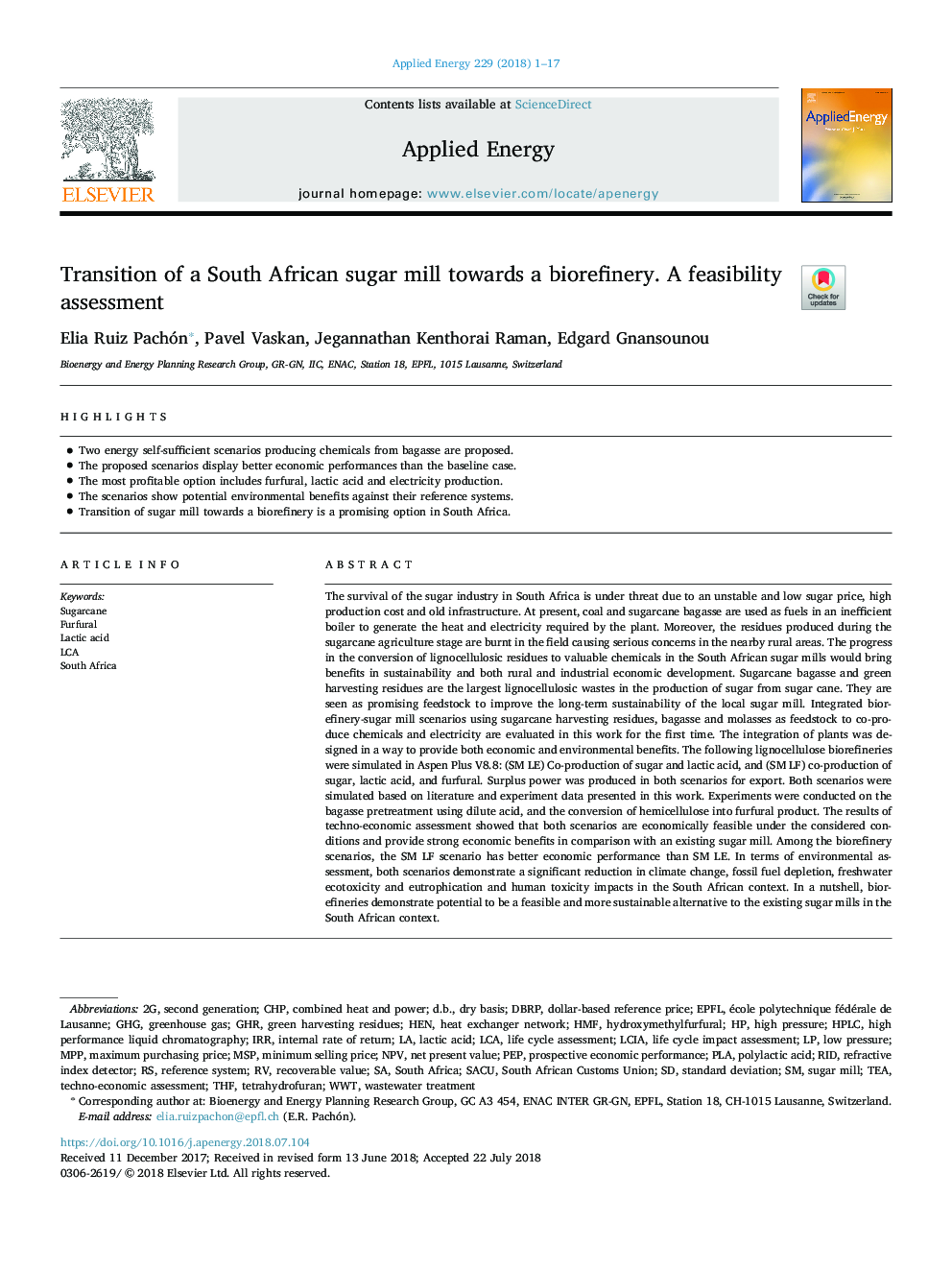| کد مقاله | کد نشریه | سال انتشار | مقاله انگلیسی | نسخه تمام متن |
|---|---|---|---|---|
| 6679632 | 1428062 | 2018 | 17 صفحه PDF | دانلود رایگان |
عنوان انگلیسی مقاله ISI
Transition of a South African sugar mill towards a biorefinery. A feasibility assessment
ترجمه فارسی عنوان
انتقال یک آسیاب قند آفریقای جنوبی به سوی کارخانه زباله. ارزیابی امکان سنجی
دانلود مقاله + سفارش ترجمه
دانلود مقاله ISI انگلیسی
رایگان برای ایرانیان
کلمات کلیدی
GHRTHFPEPHMFGHGPLAHENIRRMPPMSPLCIACHPWWTSugar mill - آسیاب شکرRefractive index detector - آشکارساز شاخص انکساریSouth Africa - آفریقای جنوبیnet present value - ارزش خالص فعلیLife cycle impact assessment - ارزیابی تاثیر چرخه زندگیTechno-economic assessment - ارزیابی فنی و اقتصادیLCA - ارزیابی چرخه حیاتLife Cycle Assessment - ارزیابی چرخه عمر یا چرخه حیاتLactic acid - اسید لاکتیکstandard deviation - انحراف معیارTetrahydrofuran - تتراهیدروفورانCombined Heat and Power - ترکیب گرما و قدرتWastewater treatment - تصفیه فاضلابMinimum selling price - حداقل قیمت فروشdry basis - خشک کردن پایهrid - خلاص شدن از شرd.b. - د.ب.reference system - سیستم مرجعHeat exchanger network - شبکه مبدل حرارتیHigh pressure - فشار بالاLow pressure - فشار کمFurfural - فورفورالNPV یا negative predictive value - مقادیر پیش بینی شده منفیInternal rate of return - نرخ بازده داخلیSecond generation - نسل دومSugarcane - نیشکرHydroxymethylfurfural - هیدروکسی متیلfurfuralPolylactic acid - پلی لاکتیک اسید یا اسید پلیلاکتیکTEA - چایhigh performance liquid chromatography - کروماتوگرافی مایع با کارایی بالاHPLC - کروماتوگرافی مایعی کاراGreenhouse gas - گاز گلخانه ای
موضوعات مرتبط
مهندسی و علوم پایه
مهندسی انرژی
مهندسی انرژی و فناوری های برق
چکیده انگلیسی
The survival of the sugar industry in South Africa is under threat due to an unstable and low sugar price, high production cost and old infrastructure. At present, coal and sugarcane bagasse are used as fuels in an inefficient boiler to generate the heat and electricity required by the plant. Moreover, the residues produced during the sugarcane agriculture stage are burnt in the field causing serious concerns in the nearby rural areas. The progress in the conversion of lignocellulosic residues to valuable chemicals in the South African sugar mills would bring benefits in sustainability and both rural and industrial economic development. Sugarcane bagasse and green harvesting residues are the largest lignocellulosic wastes in the production of sugar from sugar cane. They are seen as promising feedstock to improve the long-term sustainability of the local sugar mill. Integrated biorefinery-sugar mill scenarios using sugarcane harvesting residues, bagasse and molasses as feedstock to co-produce chemicals and electricity are evaluated in this work for the first time. The integration of plants was designed in a way to provide both economic and environmental benefits. The following lignocellulose biorefineries were simulated in Aspen Plus V8.8: (SM LE) Co-production of sugar and lactic acid, and (SM LF) co-production of sugar, lactic acid, and furfural. Surplus power was produced in both scenarios for export. Both scenarios were simulated based on literature and experiment data presented in this work. Experiments were conducted on the bagasse pretreatment using dilute acid, and the conversion of hemicellulose into furfural product. The results of techno-economic assessment showed that both scenarios are economically feasible under the considered conditions and provide strong economic benefits in comparison with an existing sugar mill. Among the biorefinery scenarios, the SM LF scenario has better economic performance than SM LE. In terms of environmental assessment, both scenarios demonstrate a significant reduction in climate change, fossil fuel depletion, freshwater ecotoxicity and eutrophication and human toxicity impacts in the South African context. In a nutshell, biorefineries demonstrate potential to be a feasible and more sustainable alternative to the existing sugar mills in the South African context.
ناشر
Database: Elsevier - ScienceDirect (ساینس دایرکت)
Journal: Applied Energy - Volume 229, 1 November 2018, Pages 1-17
Journal: Applied Energy - Volume 229, 1 November 2018, Pages 1-17
نویسندگان
Elia Ruiz Pachón, Pavel Vaskan, Jegannathan Kenthorai Raman, Edgard Gnansounou,
